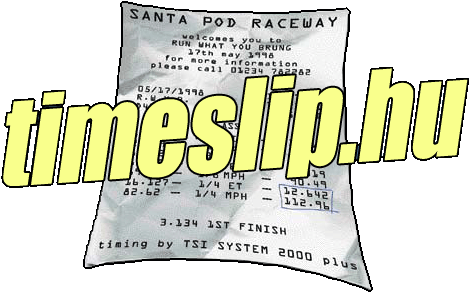
|
Frequently Asked Questions |
|
1. Where comes the site's name? What is a timeslip? A timeslip is a piece of paper, given to competitors
on drag strips. At least on proper drag strips. ;) It lists all
the details of the run: reaction time, 60 feet time, 1/8 mile
ET and speed, 1/4 mile ET and speed. Often even more, like 330
feet (100 meter) and 1000 feet (300 meter) time too. If there
was an opponent on the other lane, his details are there too.
Here is a sample,
I got this at Santa Pod Raceway (United Kingdom). A drag run has quite a few measuring figures.
The most important being the time required from standstill to
reach the finish line. This is called elapsed time, ET in short.
Another telltale figure is the speed at which the vehicle crosses
the finish line. This is called trap speed, as the speed is measured
by timing the vehicle between two light beams, one at the finish
line and the other 66 feet (20 meters) before that. The third
most important figure is the 60 feet time. This is like the ET,
time measured between the start line and a light beam at 60 feet.
Anyone who saw a dragrace knows that often the races are already
won by the time they reach this point. No wonder racers are interested
to see whether they lost time during this period or not. Above I said Elapsed time is the time required
from standstill to the finish line. Well, it's not exactly true.
Well, that's my own contrivance, to help interpret
results in various timing systems present in Hungary. 5. How is the timing works on dragstrips? The accepted international standard use two light
beams at the start line, just a few inches above ground level.
The first is called pre-stage, the second is stage. As the vehicle
inches forward, and the timing beams are broken, the white pre-stage
and stage lights come up on the christmas tree accordingly. The
pre-stage's function is only to inform the driver, that he is
getting close the start line. The christmas tree's ambers only
start to come up when both vehicles are staged properly, e.g. the
vehicles are crossing the stage beam. Some racing classes allow
deep staging, which means that the vehicle is so far forward,
that the pre-stage beam is uncovered, and only the stage light
is illuminated. On other classes it's illegal.
We use blutack to secure the meter in the
vehicle, leaves no mark. No connections are needed. On bikes we
secure it with tape as well. We log on a flat, straight and secure
stretch of road. To be secure our recommendation is to only do
a 1/8 mile run, but it's possible to run 1/4 mile, if someone
want to do so. This is not a business, I just try to cover
my costs. 1000 HUF/vehicle. (about 5 USD, 3 GBP, 4 Euro)
Well, suppose you're in Hungary. :) Otherwise
it's not possible. Not yet! But I have plans. :) |
(M) Majicright 2004. Design by ave

KISKUNLACHÁZA
OB ZÁZÓ FUTAM PART 1
Frissítve :
2010.09.11
